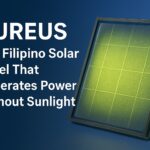AUREUS: The Filipino Solar Panel That Generates Power Without Sunlight
When we think of solar panels, we often picture rooftops bathed in bright sunlight, silently converting rays into renewable energy. But what if solar panels could generate electricity even on cloudy days, in shaded areas, or under indirect light? This once impossible idea became a reality through a remarkable Filipino invention — AUREUS, a solar panel made from recycled food waste that can capture ultraviolet (UV) light and turn it into electricity, even without direct sunlight.
At the heart of this breakthrough is Carvey Ehren Maigue, a young Filipino scientist and student from Mapúa University. His invention not only redefines solar technology but also showcases how innovation, sustainability, and Filipino ingenuity can come together to address global energy and waste challenges.
The Birth of AUREUS
AUREUS (short for AUxiliary Renewable Energy Unit System) began as a project to solve two major problems: the inefficiency of traditional solar panels in cloudy weather and the growing amount of food waste that ends up in landfills. Traditional solar panels rely heavily on visible light, which means their performance drops drastically on overcast days or when sunlight is blocked.
Maigue wondered — could there be a way to harvest another part of the light spectrum that passes through clouds more easily? His answer came in the form of ultraviolet light. UV rays, unlike visible light, can penetrate through clouds and even bounce off surfaces. This insight led him to develop a solar technology that uses UV light instead of relying solely on direct sunlight.
The materials to capture UV light came from an unexpected source — rotting fruits and vegetables.
From Food Waste to Future Power
Instead of using expensive and rare synthetic materials, Maigue found that organic luminescent compounds extracted from fruits and vegetables could absorb UV light and re-emit it as visible light. This re-emitted light can then be converted into electricity using solar cells.
These natural compounds are harvested from discarded crops and spoiled produce, making AUREUS both eco-friendly and low-cost. The system uses food waste that would otherwise contribute to methane emissions in landfills — a major contributor to global warming. Through this innovation, food waste is transformed into a sustainable energy source.
In essence, AUREUS turns agricultural and food waste into clean energy, helping both the environment and the economy. It’s a perfect example of circular innovation — where waste becomes a resource.
How AUREUS Works
The AUREUS panel is made of a transparent material embedded with luminescent particles derived from food waste. These particles absorb ultraviolet rays from sunlight — whether direct or diffused — and then re-emit visible light internally. The light bounces around inside the panel until it reaches photovoltaic cells located along the edges, where it’s converted into electricity.
What makes AUREUS revolutionary is that it can harvest energy from UV light coming from any direction, including reflections from walls, ground, or even during cloudy days. This means it doesn’t have to face the sun directly, making it ideal for cities with limited open space or tall buildings.
Imagine windows, walls, or even surfaces of high-rise buildings coated with AUREUS panels — quietly generating clean energy all day, regardless of the weather. That’s the vision Maigue hopes to achieve.
Awards and Global Recognition
AUREUS gained international attention when Carvey Ehren Maigue won the James Dyson Award for Sustainability in 2020, an international design competition that celebrates inventors solving real-world problems. His invention stood out for its creativity, feasibility, and environmental impact.
The Dyson Foundation praised AUREUS for its potential to change how we harvest renewable energy in urban environments, particularly in tropical and cloudy countries like the Philippines. Maigue became the first Filipino to win the sustainability category, putting Filipino science and innovation in the global spotlight.
Applications and Future Potential
The AUREUS system can be used in various ways — from building-integrated solar windows to vehicle surfaces, wearable tech, and even emergency power solutions. Because it can capture UV light scattered throughout the atmosphere, AUREUS has huge potential in places where conventional solar panels struggle, such as shaded urban areas, tropical climates with frequent rain, or regions with limited space for rooftop installations.
Maigue and his team envision scaling the technology for commercial and industrial use, while also continuing to refine the material’s efficiency and lifespan. His ultimate dream is to make renewable energy accessible, affordable, and adaptable for everyone — especially in developing countries that face both energy and waste management challenges.
A Step Toward a Sustainable Future
The AUREUS invention carries a powerful message: sustainability and innovation can go hand in hand. It shows how a single creative idea can address multiple problems at once — in this case, food waste reduction, renewable energy generation, and urban adaptability.
Moreover, AUREUS represents Filipino ingenuity at its finest — inventive, resourceful, and deeply rooted in the desire to make the world a better place. In a time when the planet is struggling with climate change and environmental degradation, such innovations give hope and inspiration.
Conclusion: A Bright Future, Even Without Sunlight
The story of AUREUS and its inventor, Carvey Ehren Maigue, reminds us that meaningful innovation doesn’t always come from billion-dollar laboratories — sometimes, it begins in the mind of a student determined to make a difference.
AUREUS doesn’t just redefine solar technology; it redefines what’s possible when creativity meets sustainability. By turning waste into energy and sunlight into power — even when the skies are gray — this Filipino-made invention shines a light on a future where clean energy is for everyone, every day, everywhere.








